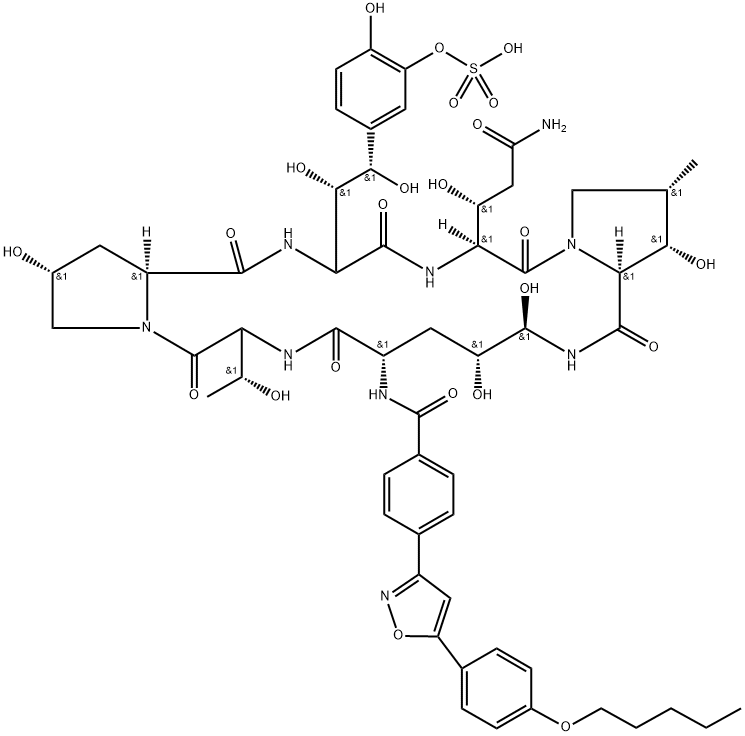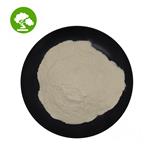
Micafungin
- Product NameMicafungin
- CAS235114-32-6
- CBNumberCB71471028
- MFC56H71N9O23S
- MW1270.28
- EINECS1806241-263-5
- MDL NumberMFCD09837852
- MOL File235114-32-6.mol
- MSDS FileSDS
Chemical Properties
| Melting point | >198oC (dec.) |
| Density | 1.62±0.1 g/cm3(Predicted) |
| storage temp. | Hygroscopic, -20°C Freezer, Under inert atmosphere |
| solubility | DMSO (Slightly), Methanol (Very Slightly, Heated) |
| pka | -4.46±0.18(Predicted) |
| form | Solid |
| color | White to Off-White |
| Stability | Hygroscopic |
| FDA UNII | R10H71BSWG |
| NCI Drug Dictionary | Micafungin |
| ATC code | J02AX05 |
Micafungin Chemical Properties,Usage,Production
Description
Micafungin (trade name Mycamine) is a kind of echinocandin antifungal drug. Its mechanism of action is through inhibiting the synthesis of beta-1, 3-glucan, which is an essential component of fungal cell walls, but not presented in mammalian cells. It works through inhibiting the beta-1,3-D glucan synthase. It can be used for the treatment of candidemia, acute disseminated candidiasis, candida peritonitis, abscesses and esophageal candidiasis. It is fungicidal against some candida, but fungistatic against Apergillus. It is also used in combinations with many other drugs such as the HIV protease inhibitor ritonavir as well as the transplant medications cyclosporine and tacrolimus.References
https://www.drugbank.ca/drugs/DB01141https://en.wikipedia.org/wiki/Micafungin
Description
Micafungin, the second member of the echinocandin class of antifungal agents was launched in Japan for the parenteral treatment of various fungal infections caused by Aspergillus and Candida spp. such as fungaemia and respiratory and gastrointestinal mycoses. This water-soluble semisynthetic cyclic lipopeptide is synthesized by acylation with (5-(4- pentyloxyphenyl)isoxazol-3-yl)benzoate of the cyclic peptide nucleus (FR-179642).obtained by enzymatic cleavage of the naturally occurring echinocandin FR-901379, derived from the fungus Coleophoma empedri Micafungin acts by inhibiting the synthesis of 1,3-beta-glucan, an essential polysaccharide of the cell wall of many pathogenic fungi. Micafungin has a marked fungicidal effect on almost all species of Candida, including fluconazole-resistant spp. C. albicans, C. glabrata, C. Krusei, C. parapsilosis and C. tropicalis and a fungistatic effect on a range of Aspergillus species including A. flaws, A. fumigates and A. terreus. Like caspofungin, micafungin is inactive against Cryptococcus neoformans, and the emerging pathogen Trichosporon cutaneum and Fusarium solani. Micafungin has proved highly effective in mouse models of Cancfidiasis and Aspergillus infections (including those using an amphotericin B- and itraconazole-resistant isolate of A. fumigatus). In phase I studies, micafungin had linear pharmacokinetics with an elimination half-life ranging from 11.7 to 15.2 h after injection and was well tolerated.Originator
Fujisawa (Japan)Uses
An echinocandin antifungal drug which inhibits the synthesis of 1,3-β-D-glucan, an essential component of the fungal cell wall, and represent a valuable treatment option for fungal infections.Uses
Micafungin is an antifungal drug that inhibits the production of β-1,3-glucan, an essential component of fungal cell walls.Uses
Micafungin is a semi-synthetic cyclic lipopeptide belonging to the echinocandin class that was reported in 1999 from Fujisawa in Japan. Unlike other marketed semi-synthetic derivatives in this class, micafungin is not derived from echinocandin but rather from FR901379 which contains a phenolic sulphate to enhance aqueous solubility, a serious limitation in the class. Micafungin inhibits the synthesis of β-(1,3)-D-glucan, an essential component of the cell wall of susceptible fungi and is extensively referenced in the literature with over 700 citations.Definition
ChEBI: A cyclic hexapeptide echinocandin antibiotic which exerts its effect by inhibiting the synthesis of 1,3-beta-D-glucan, an integral component of the fungal cell wall. It is used as the sodium salt for the treatment of invas ve candidiasis, and of aspergillosis in patients who are intolerant of other therapy.brand name
Mycamine(Astellas);Funguard.Antimicrobial activity
It is active against Aspergillus spp., Candida spp. and the cyst form of Pn. jirovecii. Resistance has rarely been reported.Pharmaceutical Applications
A semisynthetic lipopeptide derived from a fermentation product of Coleophoma empetri. Formulated as the monosodium salt for intravenous infusion.Pharmacokinetics
Cmax 50 mg 1-h infusion: c. 5 mg/L 1 h post infusionPlasma half-life: 11–15 h
Volume of distribution: 0.4 L/kg
Plasma protein binding: 99%
Blood concentrations increase in proportion to dosage. Unlike anidulafungin and caspofungin, a loading dose is not required.
Distribution
The drug is widely distributed, the highest concentrations being found in the liver. Levels in the CSF and urine are negligible.
Metabolism and excretion
It is metabolized by the liver and the three inactive metabolites are excreted in the feces (70%). Less than 1% of a dose is eliminated as unchanged drug in the urine. No dosage adjustment is required in patients with severe renal impairment or mild to moderate hepatic impairment. The effect of severe hepatic impairment on micafungin pharmacokinetics has not been studied. Micafungin is not cleared by hemodialysis.
Clinical Use
Candidemia and certain invasive forms of candidosisEsophageal candidosis
Prophylaxis of Candida infections in hematopoietic stem cell transplant (HSCT) recipients
Side effects
Occasional histamine-mediated infusion-related reactions, injection site reactions and transient abnormalities of liver enzymes have been reported. Isolated cases of significant hepatic or renal dysfunction, hepatitis, or liver or renal failure have also been described.Drug interactions
Potentially hazardous interactions with other drugsCiclosporin: possibly increases ciclosporin concentration.
Sirolimus: increases sirolimus concentration.
Metabolism
Metabolised in the liver by arylsulfatase to its catechol form and further metabolised to the methoxy form by catechol-O-methyltransferase. Some hydroxylation to micafungin via cytochrome P450 isoenzymes also occurs. Exposure to these metabolites is low and metabolites do not contribute to the overall efficacy of micafungin. After 28 days about 71% of a dose is recovered in the faeces and 12% in the urine.Preparation Products And Raw materials
Micafungin Supplier
Global(166)Suppliers
| Supplier | Tel | Country | ProdList | Advantage | ||
|---|---|---|---|---|---|---|
| +86-0571-85134551 | sales@afinechem.com | China | 15352 | 58 | ||
| +undefined18602966907 | qinhe02@xaltbio.com | China | 997 | 58 | ||
| +86-0371-55170693 +86-19937530512 |
info@tianfuchem.com | China | 21632 | 55 | ||
| +86-21-33585366 - 03@ | sales03@shyrchem.com | CHINA | 738 | 60 | ||
| +undefined-21-51877795 | ivan@atkchemical.com | China | 33025 | 60 | ||
| 323-480-4688 | sales@acrospharmatech.com | United States | 989 | 55 | ||
| +86-0371-86658258 +8613203830695 |
sales@coreychem.com | China | 29866 | 58 | ||
| 86-714-3992388 | overseasales1@yongstandards.com | United States | 14332 | 58 | ||
| +86-023-6139-8061 +86-86-13650506873 |
sales@chemdad.com | China | 39894 | 58 | ||
| 21-33585366 | export01@shyrchem.com | CHINA | 1319 | 58 |
235114-32-6, MicafunginRelated Search
PROMPT×
PROMPT
The What'sApp is temporarily not supported in mainland China
The What'sApp is temporarily not supported in mainland China
Cancel
Determine


